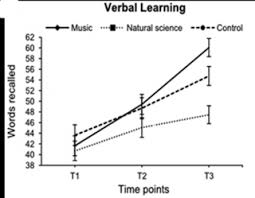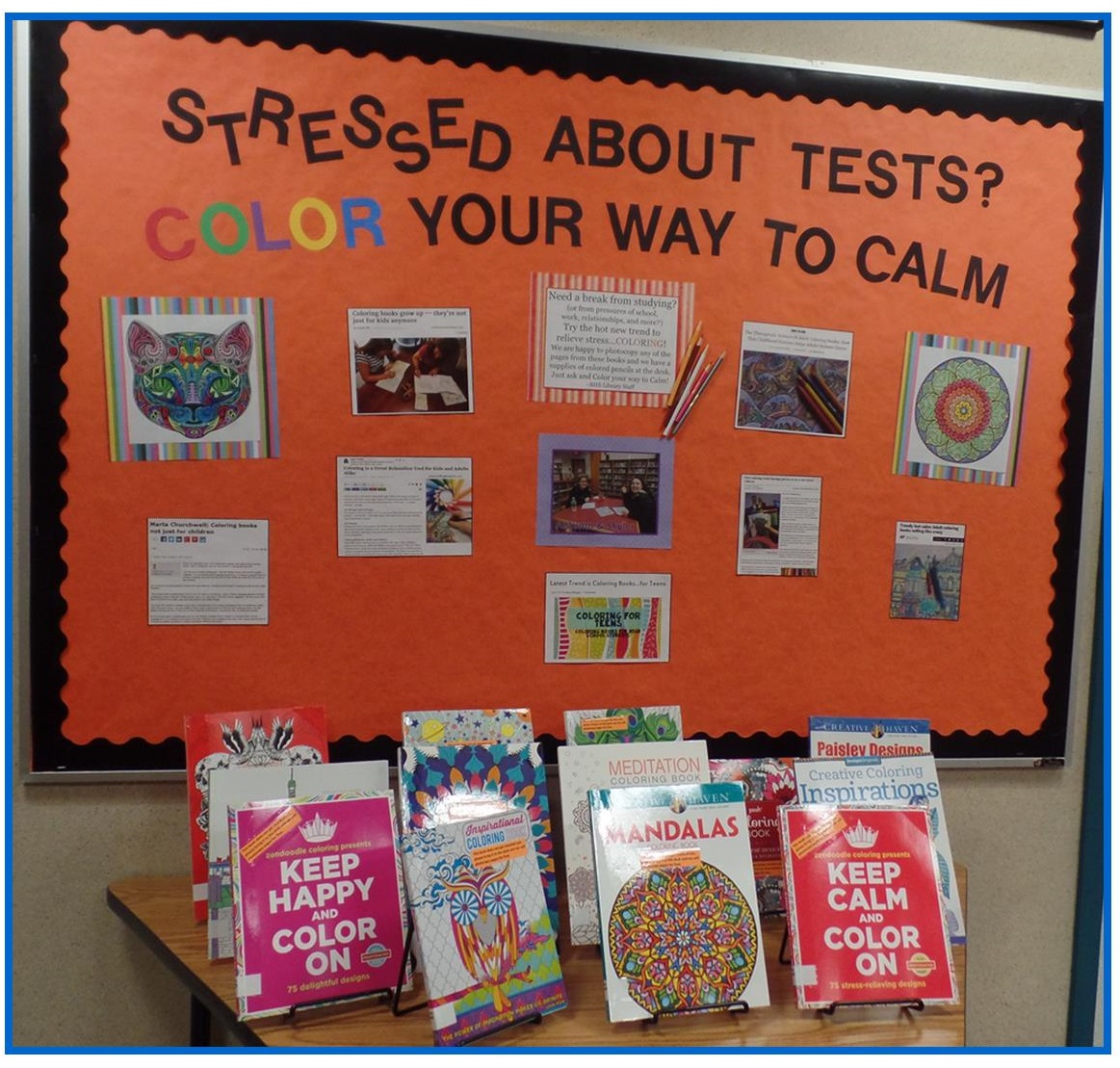Early
& Continuous Music
Lessons Improve Grades
Evelyn
Smith
M.S.
In Library Science, University of North Texas (2012)
Researchers hypothesize that the earlier a child start formal
music lessons the better. Indeed, educational psychologists have proven that it is best to begin formal training in playing a musical
instrument by age seven and keep it up through
the teenage years. Because musicians have to multi-task while they
are playing a musical instrument, this experience builds up
connections in different parts of their brain, starting at a very
young age. Of course, reading notes is similar to reading a language
since different notes represent different sounds. Thus, it comes as
no surprise that a child who learn to play an instrument early on
often shines in the classroom! However, waiting until a child is in
the third or fourth grade may be too late to reap all the benefits of
a music education.
"Music
learning supports all learning" since playing music forces a young
musician “to tap into multiple skill sets, often simultaneously”
(Brown, n. d., para. 2-3).
Early
music education, however, particularly benefits language development
since a child from age two to age nine is beginning to decode sounds
and words, and music reinforces these
skills (Brown, n. d., para. 5).
Learning
music develops the left side of the brain, which
processes language. Moreover, the relationship between music and
language development further develops social skills since
musical education strengthens verbal competency (Brown, n. d., para.
6-7).
For
example, in a University of Toronto study published in the 2004 issue
of Psychological Science, six-year-old children enrolled in either
voice or piano training scored three points higher on intelligence
tests than their peers who received drama training or acted as
controls. While the IQ's of the children taking drama classes did
not increase, they did improve their social behavior (Brown, n. d.,
para. 8-9).
Boston
College and Beth Israel Deaconess/ Harvard Medical School researchers
have also found that children who took 15 months of weekly music
instruction and practice improved their sound discrimination and
motor tasks as shown in the brain imaging of the regions of the brain
associated with these skills (Brown, n. d., para. 11). This is because a causal link between musical instruction and spatial
intelligence which helps students visualize how parts of a whole fit
together—a skill necessary for performing multiple-step math
problems (Brown, n. d., para. 12-13).
Furthermore,
elementary school students enrolled in superior music education
programs scored 22 percent higher in language and 20 percent high on
standardized tests than children who did not have this advantage
(Brown, n. d., para. 14).
Although
schools with superior music and fine art teachers most probably also
have excellent teachers in other subject areas, musical training does
help with verbal recall (Brown, n. d., para. 15-16).
 |
| Playing music makes kids happy. |
Practicing music also students be more self-disciplined, but in the end, it
keeps them “interested and happy” in school since a music
education helps children better understand themselves (Brown, n. d.,
para. 18-19).
So how does music teach verbal skills?
 |
| Music improves grades and test scores. |
Butzlaff
argues that music can be used to teach for the following reasons:
Both
music and reading use written notation where a symbol indicates a
specific sound;
While
reading requires a sensitivity to phonological distinctions, music
requires a sensitivity to tonal distinctions;
When
students learn the lyrics of songs, they read a written text that is
often repetitive and predictable;
Joining
a school orchestra or band requires students to learn to work
together. Additionally, it puts pressure on each band or orchestra
member to be responsible and work hard.
(Butzlaff, 2000,
Autumn-Winter, Abstract, p. 167)
Costa-Giomi, E. (2004,
April). Effects of three years of piano instruction on children's
academic achievement, school performance and self esteem. Psychology
of Music,
32(2), 139-152. doi:10.1177/0305735604041491. [Abstract only].
Retrieved from http://pom.sagepub.com/content/32/2/139.short
When
63 Montreal four-graders received three years of free-of-charge
individual piano lessons and received an acoustic piano, at the end
of that period, they had better self-esteem and grades in music than
the 54 students that made up a control group, but this didn't affect
the grades they received in math and language arts when compared with
the controls (Costa-Giomi, 2004, April, Abstract, p. 139).
Fitzgerald, Kate F.
(2006, spring). The effect of instrumental music participation and
socioeconomic status on Ohio Fourth-, Sixth and Ninth-Grade
Proficiency Test Performance. Journal
of Research in Music Education,
54(1), 73-84. doi: 10.1177/002242940605400106. [Abstract only].
Retrieved from http://jrm.sagepub.com/content/54/1/73.short
Instrumental
music students out-performed non-instrumental students in every
subject and at every grade level, but since the youngest instrumental
music students had higher test scores than their peers, who were not
taking music, this suggested that public school instrumental music
programs simply attract better students at the onset. Interestingly
enough, however, lower-socioeconomic instrumental music students were
academically performing all other instrumental students by
ninth-grade (Fitzgerald, 2006, spring, Abstract, p. 73).
Teachers
often use calming, peaceful instrumental music in the classroom to
help students relax and focus (Gaddy, 2013, July 14, para. 2).
Moreover students who received early music instruction have a head
start in their studies since learning to play a musical instrument
improves fine motor skills, prompts memory, and boosts thinking
ability (Gaddy, 2013, July 14, para. 3). For example, research
studies have shown that young pupils who took piano lessons scored
higher in reading and math and had higher IQ's than their
non-music-taking controls (Gaddy, 2013, July 14, para. 4).
Moreover,
the National Association of Music Educators notes that students with
a musical background score 56 points higher on the verbal section of
the Sat and 39 points higher on the SAT math section than their
non-musical peers (Gaddy, 2013, July 14, para. 5). Instrumental
music students often outperform their counterparts in algebras
as well as excelling in reading, research, and writing (Gaddy, 2013,
July 14, para. 6). Music also improves memory skils whle relieving
stress and fatigue and boosting energy (Gaddy, 2013, July 14, para.
7-8).
Gaser
and Schlaug found more gray matter in the motor, auditory and
visual-spatial regions of the brain when comparing adult professional
keyboard players with amateur musicians and
non-musicians. They hypothesize that this represents adaptions in
response to long-term skill acquisition and repetitive rehearsals
(Gaser, 2003, October 8, Abstract, p. 9240).
While
listening to music can help students relax and concentrate, it does
not make students more intelligent. However, playing a musical
instrument does hone abilities such as speech perception the ability
to understand emotion in a voice, and multi-tasking (Hicks, 2014,
July 17, para. 5-6). Evidence also exists that playing a musical
instrument early in life improves math and reading skills (Hicks,
2014, July 17, para 19). This is because researchers have discovered
a connection between learning to play a musical instrument and
improved executive functioning, which includes such skills as problem
solving, the ability to switch tasks, and focus (Hicks, 2014, July
17, para. 21).
These
executive skills are perhaps enhanced since musicians use the
auditory motor emotional, and executive centers of the brain when
playing a musical instrument with a higher degree of precision than
is necessary when processing speech (Hicks, 2014, July 17, para. 32 &
34).
This
added practice, in turn, improves other learning processes since
there is an over lap because the brain networks that process music
also handles language, memory and attention (Hicks, 2014, July 17,
para. 33).
Additionally,
playing a musical instrument requires the musician to control
emotion, understand the importance of repetition and attention—all
of which promote brain plasticity (Hicks, 2014, July 17, para. 35).
Actual
classroom experience back these findings since early elementary
school students who have problems remembering the rhythm in musical
sequences also usually have problems in reading and math (Hicks,
2014, July 17, para. 4-45).
Hyde,
K. L., Lerch, J., and Norton, A. (2009, March 11). Musical training
shapes structural brain development. Journal
of Neuroscience,
29(10), pp. 3019-3025. [Full-text]. doi:
10:1523/NEURSCI.5118=08:2009. Retrieved from
http://www.jneurosci.org/content/29/10/3019.full
Just
15 months of instrumental musical training in early childhood
correlates with the enhancement of musically relevant motor and
auditory skills. Thus, researchers conjecture that similarly brain
malleability in adult musicians as well as experts in other fields is
most likely the result of training-induced brain plasticity” (Hyde,
2009,March 11, Abstract, p. 3019).
|
|
Make sure your teen keeps up music lessons through high school.
|
A
Quebec study finds that for every year high-performing high school
students in an International Baccalaureate program stayed in music
classes beyond their compulsory two years, their mean grades were
higher (Jacobs, 2013, August 26, para. 1-3). Nevertheless, these
results do not prove casualty since it is possible that these
students might otherwise be the smartest and most highly motivated
students in a highly-motivated set of students (Jacobs, 2013, August
26, para. 5).
Building
on a study in which six-year-old pupils who took voice or music
lessons did better than a control group who did not take music
lessons, E. Glenn Schellenberer argues that studying music initiates
a dose-response association in which the longer a child takes music
lessons, the higher his or her IQ and school grades will eventually
be (Munsey, 2006, June, para. 1-2 & 5). To obtain these results,
Schellenberger studied children age 6 through ll as well as university
freshman (Munsey, 2006, June, para. 6).
Accordingly
to Schellenberger for each additional month of music lesson a young
child takes, he or she increases his or her IQ By 1/6th
of a point, so six years of continuous music lessons would raise an
IQ by 7.5 points when compared with students who do not study
music (Munsey, 2006, Jun, para. 9). Moreover, university students who
spent six years playing music regularly increased their IQ's by two
points over their non-music playing university peers (Munsey, 2006,
June, para. 10).
Indeed,
Schellenberger argued that taking music lessons during childhood was
a “significant predicator” of a higher IQ in young adulthood
and higher grades while younger children who took music lessons are
more likely to make higher grades as well as higher scores on
achievement tests in math, spelling, and reading (Munsey, 2006, June,
para. 11).
Schellenberger
research indicates that after controlling for a student's family
income, parents' level of education, and the student's gender,
playing music regularly from kindergarten through high school
correlates with a “small but significant” bump in grades and
IQ (Munsey, 2006, June, para. 12).
Just
as the brains of older adults who had music lessons as children
respond faster than their counterparts who did not learn how to play
a musical instrument, formal musical traning also accelerates the
brain development in children since more areas of the brain are at
work when playing a musical instrument than when speaking (Music &
brain development, 2015, para 3-4).
Thus,
following these suggestions, parents should make music an important
part of their preschool and early-elementary school children's lives:
Expose
children to live and recorded musical performances as well as to
different styles and types of music;
Start
formal instruction in learning to play an instrument early;
Sing
with young children and play musical games with them;
Support
local music education programs.
(Music & brain
development, 2015, para. 5)
Piro,
J. M. and Ortiz, C. (2009, March 16). The effect of piano lessons on
the vocabulary and verbal sequencing skills of primary grade
students. Psychology
of Music,
37(3), pp. 325-347. doi: 10.1177/0305735608097248. [Abstract only].
Retrieved from http://pom.sagepub.com/content/37/3/325.short
When researchers
compared a group of 46 second-grade students who had formally studied
piano for three years with a control group of their peers who had no
formal musical instruction, they discovered that the students who
had taken piano lessons possessed “significantly better”
vocabulary and verbal sequencing skills (Piro, 2009, March 16,
Abstract, p. 325).
Research
has revealed differences in the brains of adult instrumental
musicians when compared with their non-musical controls since "musicians acquire and continually practice a variety of complex
motor, auditory, multiple-modal skills." Similarly, early
instrumental training in children improves their long-term visual,
spatial, verbal, and mathematical performances (Schlaug, 2005,
December, Abstract, p. 219).
Steele,
C. J., Bailey, J. A. and Zatorre, R. J., et
al.
(2013, January 16). Early musical training and white-matter
plasticity in the corpus
callosum: Evidence
for a sensitive period.
Journal of Neuroscience,
3(3), pp. 1282-1290.
doi: 10.1523/JNEUROSCI.3578-12.2013. [Full text]. Retrieved from
http://www.jneurosci.org/content/33/3/1282.full
When
Concordia University, McGill University, and Max Planck Institute
researchers compared the white-matter organization in the brains of
early and late-trained musicians matched for years and experience,
they found that those musicians that formally studied music before
age seven possessed "greater connectivity" in the region of the
brain related to sensory motor synchronization experience. The
researchers posit that early musical training results in more
white matter connectivity, which will, in turn, serve as a scaffold
on which to build future skills (Steele, 2013, January 16, Abstract).
The
researchers reached this conclusion after testing 36 musicians,
dividing them into two groups, those who began formal training
before age seven and those who started later. All of the musicians
had at least seven years of formal musical training and were either
enrolled in a university music program or were performing
professionals. The researchers then compared these two groups to
six controls, who did play music (Steele, 2013, January 16, para. 6).
All
participants then completed a motor sequencing task, synchronizing a
ten-element sequence of short and long visual cues that formed a
temporal sequence or rhythm by tapping out the beats (Steele, 2013,
January 16, para. 7).
Researchers
theorized that playing a musical instrument necessitates hand
coordination with inter-hemispheric interaction—a task that
requires bi-manual skills. This places more demands on
inter-hemispheric interactions between sensory-motor regions at a
critical time in life for learning music (Steele, 2013, January 16,
para. 26).
Wan,
C. Y. and Schlaug, G. (2010, October). Music making as a tool for
promoting brain plasticity across the life span. The Neuroscientist,
16(5), pp. 566-577. doi: 10.1177/1073858410377805. [Full text].
Retrieved from http://www.ncbi.nlm.nih.gov/pmc/articles/PMC2996135/
Musicians
learn and repeatedly practice motor actions that cause specific sound
and visual patterns while receiving constant and immediate feedback
on their performance. This combination of factions strengthens the
connections between the auditory and motor regions of the brain while
activating the region of the brain that integrates these various
skills. Wan and Schlaug therefore argue that the training of this
neural network also heightens other cognitive skills and behavioral
reactions (Wan, 2010, October, Abstract, p. 566).
Some
musical beats encourage critical thinking and develop math concepts (2013, August 30, para. 1).
Organized
Music
Since
taking music lessons for a longer period of time increases their
effect, teens should continue to take music lessons as long as
possible, for doing so will increase their chances of making better
grades (White, 2013, August 30, para. 2).
Background
Music
Playing [instrumental]
music in the background while studying may help students feel more
comfortable; and if they are studying in a group, music creates a
“privacy barrier” that helps some student more willing to
contribute (White, 2013, August 30, para. 3).
__________
Musical
Training Starts in
|
|
Kids need to be a part of music.
|
Starting
in nursery-school, children can benefit from exposure to music if
they participate in making it—singing songs with hand motions,
moving their bodies to the beat, and playing in a rhythm band.
However, listening to music at this stage can be important too since
it can either energize the children or put them to sleep. Music also
helps children diagnosed autism spectrum disorder to concentrate and
better relate to others.
Incorporating
music into early childhood experiences enhances children's ability to
learn, sharpens their mental focus, and adds to a “sensory-rich”
environment that promotes the development of neural pathways
(Chaloux, 2016, para. 1).
Actively
Experience
Preschoolers
and early elementary school students respond best to music when they
actively participate in making it. Accordingly, show them how to
move to both slow and fast-moving beats and then use different tempos
to help them build their listening skills. Also, sing songs together that include hand
motions and finger plays since combing music and movement helps
children coordinate and control body movements while they develop
self-control and learn to concentrate (Chaloux, 2016, para. 2).
Academic
Concepts
Teach
academic concepts like the alphabet, counting, and the multiplication
tables through music, handing out tambourines, shakers, and drums to
have children tap to a beat. This incidentally builds auditory
discrimination, which helps children learn to sound out words. Sing
together a variety of song to build vocabulary and language skills,
and help them learn to recognize mathematical pattern and reasoning
skills by having them tap and clap out a rhythm (Chaloux, 2016, para.
3).
Comfort
Children
often use music to comfort and soothe themselves, so incorporate
music into their daily routines; for example, singing songs on the
way to a new school to ease their anxiety, humming a lullaby at
bedtime to lull them to sleep, or popping an appropriate CD into the
CD player to spur them to clean up their toys (Chaloux, 2016, para.
4).
Expose
children to different genres and styles of music, like classical,
folk, and jazz, while incorporating singing, dance, and music into many
of their daily activities. Checking out music CD's at the public
library [as well as playing previewed and age-appropriate YouTube
videos] are free-of-charge ways to expose young children to music
(Chaloux, 2016, para. 5).
Gruhn separated twelve
urban, upper middle class German one- and two- year-old children into
experimental and control groups, and for the next 15 months, the
children in the control group had no exposure to music apart from the
songs sung in a local daycare program while the children in the
experimental group were place in a stimulating musical environment.
At the end of this period, the control group's body movements and
vocal performance were significantly less developed than their
experimental counterparts, who showed more adroit motor co-ordination
and voiced more sophisticated tonal and rhythm patterns (Gruhn, 2002,
Abstract, p. 51).

